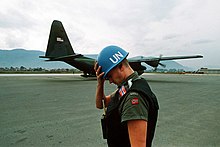Main Department of Peacekeeping Operations
| UN Department of Peacekeeping Operations United Nations Department of Peacekeeping Operations |
|
|---|---|
 |
|
| Organization type | Main Department of the UN Secretariat |
| Abbreviation | DPKO |
| management |
Jean-Pierre Lacroix France since 2017 |
| status | active |
| Founded | 1992 |
| Headquarters |
New York United States |
| Upper organization |
|
| DPKO website | |


The main department of peacekeeping operations ( French: Département des opérations de maintien de la paix ; English Department of Peacekeeping Operations , DPKO ) is a main department of the UN Secretariat founded in 1992 and replaces the Office of Special Political Affairs . The DPKO leads, on behalf of the UN Secretary General, the United Nations peacekeeping forces deployed by the member countries in observer and peace missions . It leads some political missions and the Mine Action Service of the United Nations (English: United Nations Mine Action Service , UNMAS) for the coordination of demining explosive and removing remnants of war responsibility. The peacekeeping forces are under the operational command of a commander who receives instructions from the UN Secretary-General or from a special envoy of the Secretary-General.
These peacekeeping and peacekeeping measures are only possible if the United Nations Security Council or the UN General Assembly so decide and the parties involved in the conflict agree. The consent can be withdrawn. For example, UNEF I had to leave Sinai on May 16, 1967 at the request of Egypt . Peace enforcement measures are generally not carried out by the DPKO but by the member states.
The head of the DPKO with the rank of Under-Secretary-General has been the French Jean-Pierre Lacroix since April 1, 2017 . Lieutenant General Carlos Humberto Loitey from Uruguay has been serving as military advisor since 2016 and Stefan Feller from Germany as police advisor since April 2013.
Head of the Peacekeeping Operations Department
| Period | Surname | nationality |
|---|---|---|
| 1992-March 1993 | Marrack Goulding |
|
| March 1993-December 1996 | Kofi Annan |
|
| January 1997-October 2000 | Bernard Miyet |
|
| October 2000-June 2008 | Jean-Marie Guéhenno |
|
| June 2008-September 2011 | Alain Le Roy |
|
| September 2011-March 2017 | Hervé Ladsous |
|
| Since April 2017 | Jean-Pierre Lacroix |
|
staff
In February 1993 the General Assembly decided with resolution 47/71 that the member states should provide military personnel for the DPKO. In 1997 a total of 111 officers were provided, 69 from NATO countries and 19 from countries close to the US. In September 1997 the system was changed with the UN resolution 51/243, and since then the DPKO has paid its own military personnel itself, only specialists may be provided free of charge by the member states of the UN, which in 1999 was due to pressure from developing countries (da Specialists can often only be paid by rich countries and thus a supremacy could arise) was hired.
United Nations standby system
This system ( UN Stand-by Arrangements System - UNSAS) is a list of troops, material and equipment which has existed since 1994 and which can be available within 30 to 90 days after the start of a new operation. Each member state determines its own offer. Around 100,000 soldiers, police officers and other experts are currently registered. In training centers, e.g. B. in the UN training center of the German armed forces in Hammelburg , they are trained according to UN standards.
The United Nations Multinational Brigade of Rapid Reaction Forces (SHIRBRIG) , founded on the proposal of Hans Hækkerup and built up with the support of the UN, was a supplement . It existed from December 15, 1996 to June 30, 2009. The rapid reaction force was to be deployed at the beginning of a peacekeeping mission and then replaced by other troops. The following countries took part: Argentina, Denmark, Finland, Ireland, Canada, Italy, Lithuania, the Netherlands, Norway, Austria, Poland, Portugal, Romania, Sweden, Slovenia and Spain. These states were observers: Chile, Jordan, Senegal, the Czech Republic and Hungary. The largest mission with around 700 soldiers was in 2000 on the border between Ethiopia and Eritrea ( United Nations Mission in Ethiopia and Eritrea ). There were other missions with the UN missions UNOCI , UNMIL , UNAMIS and UNMIS .
A quickly relocated headquarters , the Rapidly Deployable Mission Headquarters (RDMHQ), is being planned.
United Nations supply base
The DPKO has had a permanent facility in Brindisi for its logistics needs since 1994 , the " United Nations Logistics Base ". With parts of the material stored there (called “Strategic Material Reserve” - Strategic Deployment Stocks , SDS), a new mission can be started more quickly.
Peacekeeping Best Practices Section
Since 2001 the DPKO has had the “Group Best Practices in Peacekeeping” (PBPU), in which the experiences from previous missions are processed. In July 2005, the division was renamed “Best Practices in Peacekeeping” (PBPS).
Web links
- Peacekeeping Operations Department website (multilingual)
- Article on the reform of the DPKO with organizational chart (PDF file; 599 kB)
- Multinational Standby High Readiness Brigade for United Nations Operations (SHIRBRIG )
- Report of the "Expert Group on UN Peace Missions" by Lakhdar Brahimi (English)
swell
- ↑ icbl.org: United Nations Mine Action Service
- ↑ un.org: UNEF I November 1956 - June 1967
- ↑ Stefan Feller appointed chief police advisor to the UN Secretary General. Retrieved October 9, 2017 .
- ↑ http://www.un.org/News/fr-press/docs/2010/SGSM13011.doc.htm un.org
- ↑ un.org biography of Kofi Annan
- ↑ http://www.un.org/apps/newsFr/newsmakersF.asp?NewsID=31 un.org press release, appointment of Alain Le Roy
- ↑ http://www.un.org/apps/newsFr/newsmakersF.asp?NewsID=35 un.org press release appointment of Hervé Ladsous
- ↑ carlisle.army.mil: Is the UN Peacekeeping Role in Eclipse?